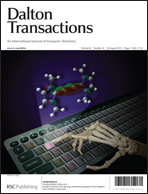Novel intercluster compounds [{(Au{P(p-RPh)3})2(μ-OH)}2]3[α-PM12O40]2·nEtOH (R = Me, M = W for 1; R = Me, M = Mo for 2; R = F, M = Mo for 3) were synthesized by the polyoxometalate (POM)-mediated clusterization of monomeric phosphanegold(I) complexes, and unequivocally characterized by elemental analysis, TG/DTA, FTIR, X-ray crystallography, and 1H and 31P{1H} NMR. In each cluster cation, two digold(I) units, {Au{P(p-RPh)3})2(μ-OH)}+, dimerized to form the tetragold(I) cluster cation by interdimer aurophilic interactions, i.e., a dimer of dinuclear units, and these cations showed different forms of structural dimerization, i.e., a crossed-edge arrangement for 1 and 2 and a parallel-edge arrangement for 3, depending upon the substituent on the aryl group of triarylphosphanes. The dimerization of digold(I) cations was affected by not only the type of the POMs, but also the phosphane ligand of the monomeric phosphanegold(I) precursors.
![Graphical abstract: Two types of tetranuclear phosphanegold(i) cations as dimers of dinuclear units, [{(Au{P(p-RPh)3})2(μ-OH)}2]2+ (R = Me, F), synthesized by polyoxometalate-mediated clusterization](/en/Image/Get?imageInfo.ImageType=GA&imageInfo.ImageIdentifier.ManuscriptID=C3DT51412A&imageInfo.ImageIdentifier.Year=2013)

 Please wait while we load your content...
Please wait while we load your content...